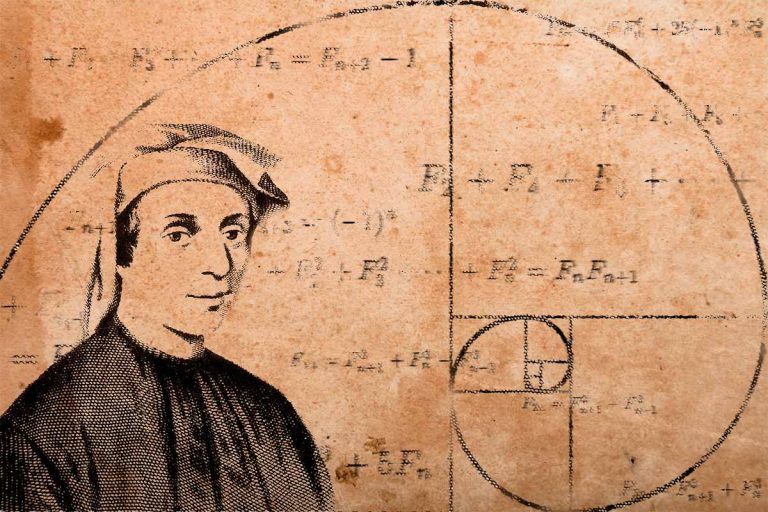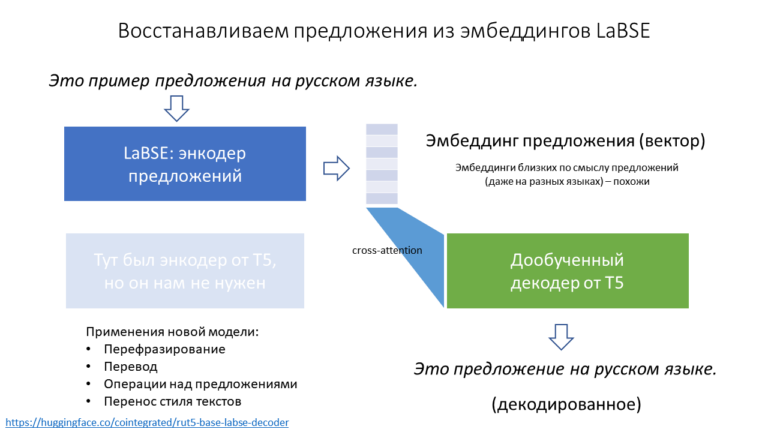Tesla Full Self-Driving Beta on city roads
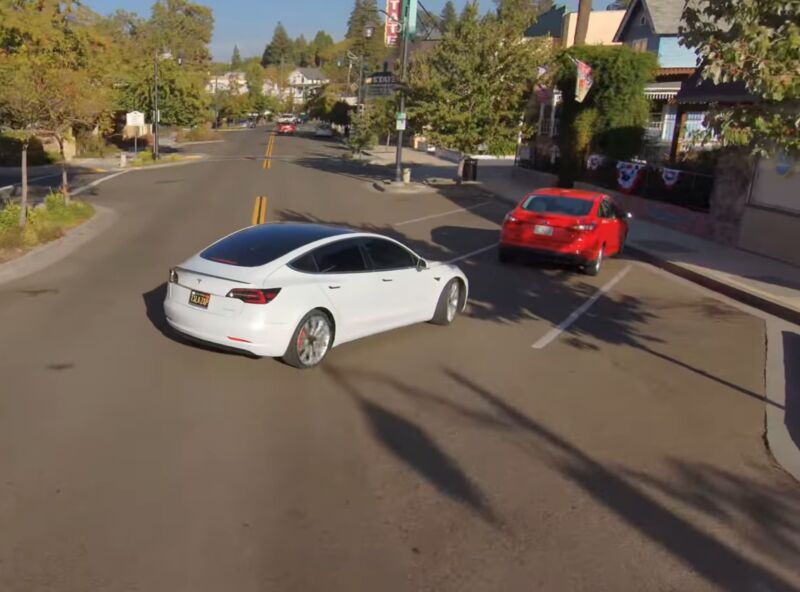
Youtuber Brandon M. filmed footage from a drone in which his Tesla decided to smash into the rear of a parked car. “Oh my God,” he said, grabbed the wheel and pulled out.
Last week, some Tesla car owners got access to an early version of the highly anticipated self-driving software. This is possibly the biggest Autopilot update Tesla has ever seen. This software allows cars to move freely, make decisions in most common driving situations and make many journeys.
Tesla claims that this is a beta version and that it is not intended to be fully self-driving yet. Drivers are expected to follow the road and keep their hands on the steering wheel.
To draw conclusions about the new software, I watched more than three hours of video recordings of the updated autopilot from users who got access to this system. These videos make it clear how important driving control is when using Tesla’s new software. Over the course of three hours, the drivers took over more than ten times, and on at least two occasions the car was close to crashing into another car.
On the one hand, even such achievements of Tesla are very impressive. On the other hand, this software will have to go a long way before replacing a person. An experienced human driver can drive thousands of kilometers without making serious mistakes. The new software is not yet capable of this.
“She’s insane, scary and incredibly cool.”
“The car was going very fast,” Brandon M. said, disengaging the autopilot and applying the brakes.
A video posted last Friday shows Tesla owner Brandon M. driving up to a four-road junction at night using a self-driving system. The car stopped at the stop sign and began to accelerate. A second later, Brandon turned off the self-driving system and applied the brakes as another car was passing the intersection.
“My car was going so fast,” Brandon said. “I had to take control, because the system somehow didn’t find another car on the road.”
Drone view:
Review of Russian eyewitnesses:
In another video, Brandon’s Tesla turned left, but did not do it sharply enough – she could crash into a car parked on the opposite side of the intersection. “Oh my God,” Brandon said, grabbing the steering wheel and yanking it to the left. “Oh my God,” added Brandon’s passenger.
“Here’s a good example, which shows that while this is just a beta version – it is very important not to be distracted from management,” Brandon said. “She was just driving into the back of a parked car and was not going to brake.”
To be honest, we’re not sure any of these incidents would necessarily lead to an accident. Perhaps the program would realize its mistake and hit the brakes at the last second. Brandon’s overall impression of the technology was positive.
A few minutes ago, Brandon was in awe of the software’s performance. “The car is going much smoother than it was two days ago,” says Brandon. “The improvements over the previous two versions of the software are incredible.”
The other two drivers also had mixed feelings. They were impressed by the improvements in the software, but they all took control when the program’s behavior made them nervous.
“She’s insane, scary and incredibly cool,” Tesla owner Zeb Hallock said in a video posted Sunday. Hallock had just taken control because a cyclist was passing through a bend in the road. Although the car shifted to leave room for the cyclist, Hallock said, “She just wobbled, the road curved and I wasn’t sure. Even if all this was completely safe, such wagging could frighten someone. “
Tesla owner James Locke had fewer mistakes than the other two YouTubers. However, at some point, and he took over control, because the car “pressed too hard to the right”, approaching the intersection. He was impressed that the car recognized the building cones in front of it and changed lanes – a feature Tesla unveiled a few months ago.
Tesla’s rivals are wary
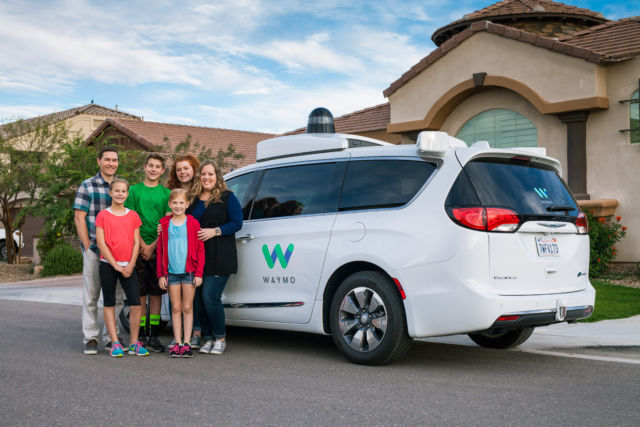
One of the first families to publicly test Waymo products in Phoenix in front of a Waymo minivan.
Tesla rivals (such as Alphabet, Cruise and GM) have spent billions of dollars developing their own self-driving systems. In recent months, some of them have been confident that their cars are fully prepared to drive on autopilot. However, it is possible to find out whether this is true only by releasing these cars on public roads and allowing them to drive without human control. If companies are quick to do this, they might kill someone.
That is why companies have been careful about this trait – they were looking for ways to test their software as thoroughly as possible before they abandon the test constraints.
For example, since 2017, Waymo has operated a fleet of self-driving taxis in Phoenix, a suburb of Chandler, and almost all of the vehicles are driven by a human driver. Earlier this month, after more than three years of testing, Waymo began offering driverless taxi rides. However, this was as early a launch as you can imagine. Services are provided in a limited area of 80 square kilometers in Phoenix. To begin with, the company makes fewer than 100 trips a week, and travel is closely monitored by staff at the Waymo operations center in Chandler, Arizona.
Cruise is taking a similar approach – the company plans to launch a low-speed taxi service in one of the San Francisco neighborhoods later this year.
Tesla’s business model is built around car sales, not taxi services. Thus, the company chose a radically different testing strategy. Instead of trying to implement and roll out a complete self-driving system right away, the company started with a basic lane control system and gradually expanded its capabilities over 4 years. This strategy allowed the company to launch a fully self-driving car last week – now Tesla cars can make most of the trips from start to finish.
Big Tesla Game
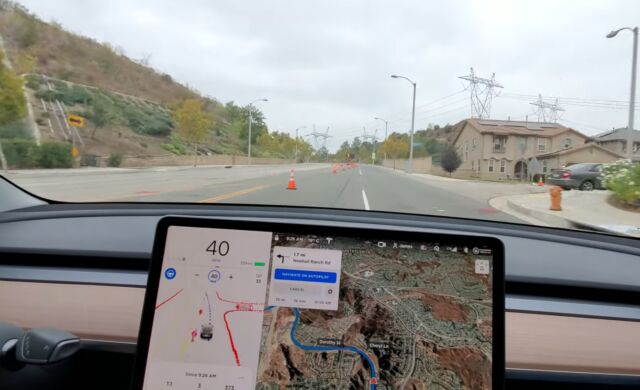
Tesla’s self-driving software detects traffic cones and changes lanes
Rather than hiring professional drivers to monitor safety, Tesla relies on customers to monitor their vehicles and prevent accidents. It didn’t quite work. At least three Tesla owners have died because the drivers were unable to take over.
Tesla has collected massive amounts of real data that can be used to improve its software. If Tesla fulfills its plan to roll out its self-driving software widely over the next few months, the company can accelerate its software development processes. However, there may be risks to the lives of their customers (and other people on the road).
Tesla drivers may not be able to effectively control a vehicle that is safe 99 percent (or even 99.99 percent) of the time. Indeed, Google found itself in a similar situation in 2012, when the company gave its employees the opportunity to try out a self-driving system on highways. It turned out that some employees began to trust the car too much and stopped paying close attention to the road. The experience scared Google executives so much that they gradually abandoned plans to deploy self-driving systems – and this is the philosophy Tesla now adheres to.
Even professional drivers have a hard time keeping an eye on the road. In 2018, an Arizona woman was killed in a collision with an unmanned Uber prototype. So far, Tesla has given access to its system to a limited number of users – those who can understand that this is only a beta version and are willing to be vigilant. But even if human drivers are very careful during the test, they can relax over time. Also, if Tesla makes this software publicly available, it will be much more difficult to maintain a high level of customer engagement.
Previously, autopilot systems were mainly used on freeways with wide shoulders and few obstacles. On city streets filled with pedestrians, bicycles and other obstacles, this system is more difficult to control. Even if the driver is very attentive, the person’s reaction time may not be enough to intervene and prevent a tragedy.
While Tesla has made real progress, the company still has a long way to go. Early videos suggest that Tesla’s software makes more mistakes than experienced drivers.
In fact, it’s really incomprehensible – is Tesla’s self-driving technology better than competitors’ solutions, or is Tesla just taking big risks (compared to more established companies)? Mercedes Benz, for example, unveiled a prototype car in 2013 that had most of the features of Tesla’s modern self-driving system. Since then, many other manufacturers have worked on similar technologies. Weren’t they able to bring their solutions to market because their technology is worse than Tesla’s, or he just didn’t want to risk it? There is no answer to this question yet.
- Russia’s first serial control system for a dual-fuel engine with functional separation of controllers
- In a modern car, there are more lines of code than …
- Free Online Courses in Automotive, Aerospace, Robotics and Engineering (50+)
- McKinsey: rethinking electronics software and architecture in automotive

You will have the opportunity to develop software of different levels, test, launch into production and see in action the finished automotive products that you had a hand in creating.
The company has organized a special testing center, which makes it possible to conduct research in the field of ICE control, including in a car. The testing laboratory includes motor boxes, drum stands, temperature and climate control units, vibration stand, salt fog chamber, X-ray unit and other specialized equipment.
If you are interested in trying your hand at solving the problems that we have, write in a personal.
- Senior Software Engineer
- Systems Analyst
- Calibration Team Leader
- Lead Test Engineer
- Requirements Engineer
- Electromagnetic Compatibility Engineer
- Systems Analyst
- Senior Engineer-ICE Engineer
We are, perhaps, the strongest center of competence in the development of automotive electronics in Russia. Now we are actively growing and have opened many vacancies (about 30, including in the regions), such as software engineer, design engineer, leading development engineer (DSP programmer), etc.
We have a lot of interesting tasks from car manufacturers and concerns that are driving the industry. If you want to grow as a specialist and learn from the best, we will be glad to see you in our team. We are also ready to share our expertise, the most important thing that happens in automotive. Ask us any questions, we will answer, we will discuss.
- Free Online Courses in Automotive, Aerospace, Robotics and Engineering (50+)
- [Прогноз] Transport of the future (short-term, medium-term, long-term horizons)
- The best materials on hacking cars from DEF CON 2018-2019
- [Прогноз] Motornet – data exchange network for robotic transport
- Companies spent $ 16 billion on self-driving cars to capture $ 8 trillion market
- Cameras or lasers
- Autonomous cars on open source
- McKinsey: rethinking electronics software and architecture in automotive
- Another war of operating systems is already underway under the hood of cars
- Program code in the car
- In a modern car, there are more lines of code than …


